Groundwater Contamination In Missouri Kept Secret From Residents
7:17 minutes
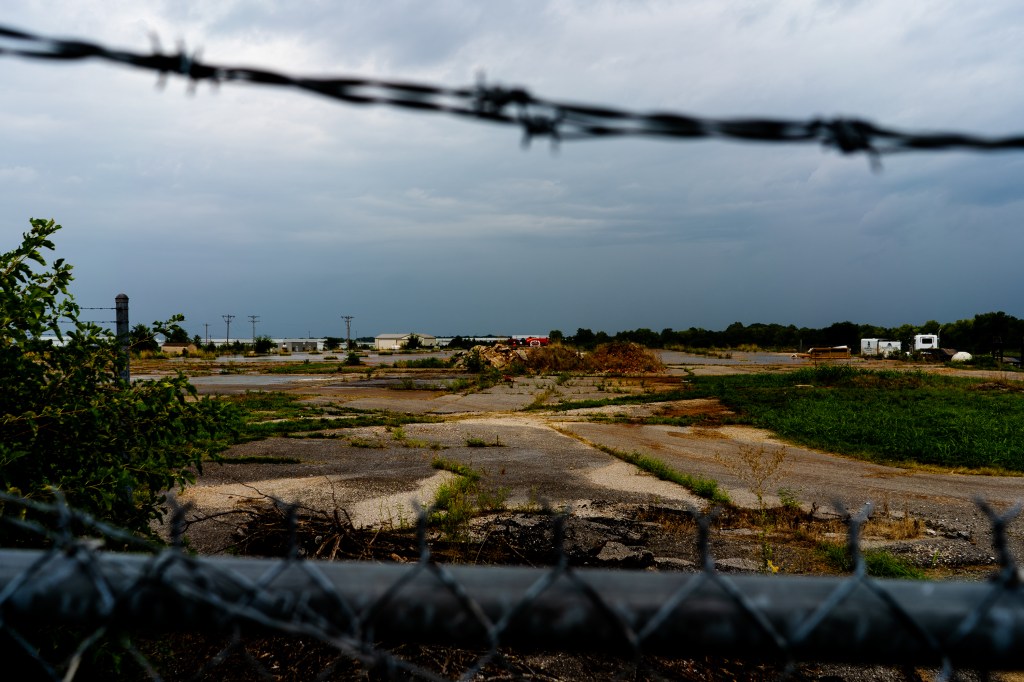
This article is part of The State of Science, a series featuring science stories from public radio stations across the United States. This story, by Eric Schmid and Steve Vockrodt, was originally published by St. Louis Public Radio and the Midwest Newsroom.
Early in 2019, Ed Galbraith faced a crowd of some 200 unhappy Springfield, Missouri residents. He wanted to make amends.
Galbraith, then director of Missouri Department of Natural Resources’ environmental quality division, acknowledged that the state agency in charge of protecting the environment should have announced sooner that contaminated water had spread from an old industrial site near the Springfield-Branson National Airport. Residents had recently found out that a harmful chemical known to cause cancer had been detected in the groundwater.
The contamination came from the site of the now-shuttered Litton Systems, a former defense contractor that had employed thousands of people in Springfield to make circuit boards for the Navy and telecommunications industry.
Litton used a toxic solvent called trichloroethylene (TCE) to wash the circuit boards and for years improperly disposed of it. The pollutant leached into the groundwater and into aquifers deep below the ground. It then spread to nearby properties, where it made its way into wells that supplied water to those who lived and worked near Litton.
The plant closed in 2007, six years after defense contractor Northrop Grumman bought Litton. Even after Northrop Grumman demolished the facility, the contamination problem lurked below the surface.
“For those people for whom this came as a surprise, especially for those who had TCE in their (water) wells and didn’t know it, I apologize,” Galbraith said at a public forum on March 13, 2019. “We didn’t tell people about it in a timely manner.”
But the problem was not broadly known in Springfield until TCE was detected and publicized in 2018 at Fantastic Caverns, a tourist destination about five miles north of the former Litton site.

Galbraith did not say when the public should have been informed about the contamination.
An investigation by the Midwest Newsroom and St. Louis Public Radio found that the Missouri Department of Natural Resources (DNR) and Litton knew as early as 1993 that contamination beyond the company’s property into the surrounding community “had undoubtedly occurred,” as one DNR employee put it at the time.
A review of thousands of pages of government records and interviews found that DNR employees raised concerns about the contamination and implored the agency to force Litton to investigate further. But in the years that followed, neither the company nor DNR sought to determine the extent of the problem or alert the public about the potential risks, our examination found. Instead, both relied on a remediation system to remove the TCE, a measure that the government later determined did not work to effectively contain the contamination.
One of the DNR employees raising concerns in the 1990s, geologist Peter Price, said that companies found to have caused pollution often resisted environmental investigations that extend beyond their property.

“Their liability was manageable, relatively speaking, if the problem remained on their property,” Price said. “Once it’s demonstrated that contamination goes off site, it opens up a much larger and, following that, more costly liability for the responsible party.”
In 2002, an investigation into an unrelated environmental incident at the Springfield airport turned up the presence of TCE in the groundwater, even though the airport did not use the solvent.
At that time, DNR concluded that Northrop Grumman’s Springfield operation caused the TCE problem and told the company to do something about it. Even then, Northrop Grumman argued at the time that other companies in Springfield used TCE and may have caused the contamination. That’s despite a 1993 EPA report estimated that Litton dumped 193.8 million gallons of wastewater from its circuit board manufacturing into pits and sinkholes on its property.
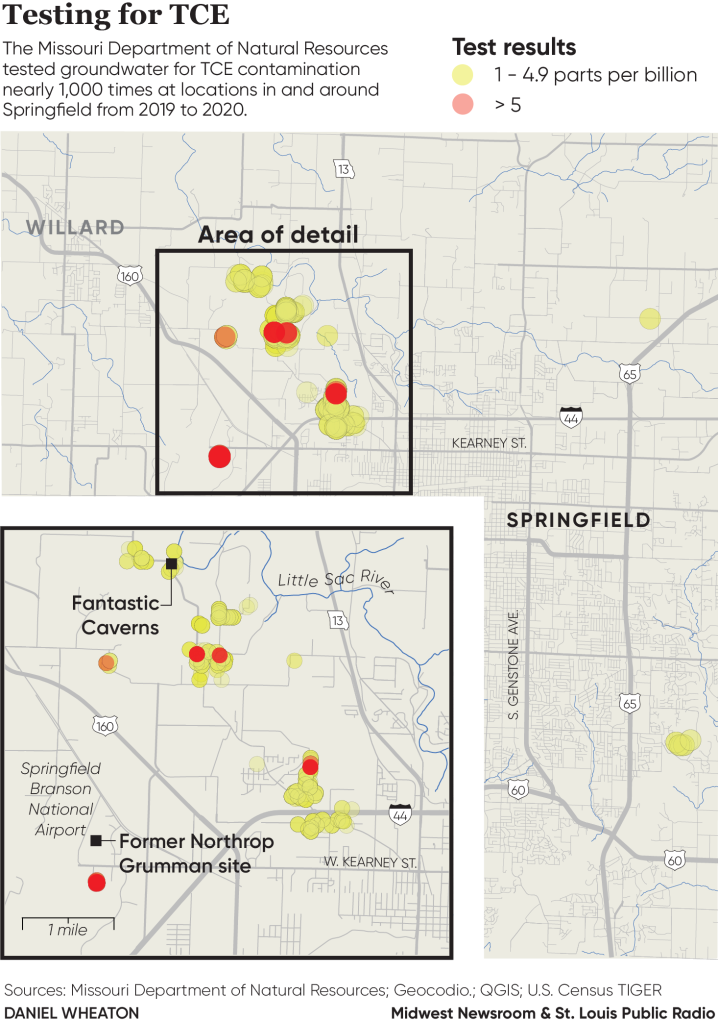
Yet, the public was not broadly notified about the presence of TCE and its risks until the owners of Fantastic Caverns went public in 2018 about the contaminant showing up at the attraction.
DNR declined an interview, but in a response to written questions for this story the agency said it did not issue a press release in 2002. Instead, it said it reached out to individual property owners, residents and workers in the area where an investigation was being performed. But without wider knowledge of the contamination until 2018, some property owners were overlooked in that process.
“It became evident in 2018 that we missed some wells, and we apologize for that oversight,” DNR spokesperson Connie Patterson said in an email response to written questions from the Midwest Newsroom and St. Louis Public Radio.
As a result, some people bought property without knowing that they would be exposed to a chemical linked to cancer and other medical conditions. Others are left wondering how long they’ve been drinking and bathing in water tainted with TCE. And still others are upset that an agency tasked with protecting the environment did not do more to warn the public about the risks of contamination.
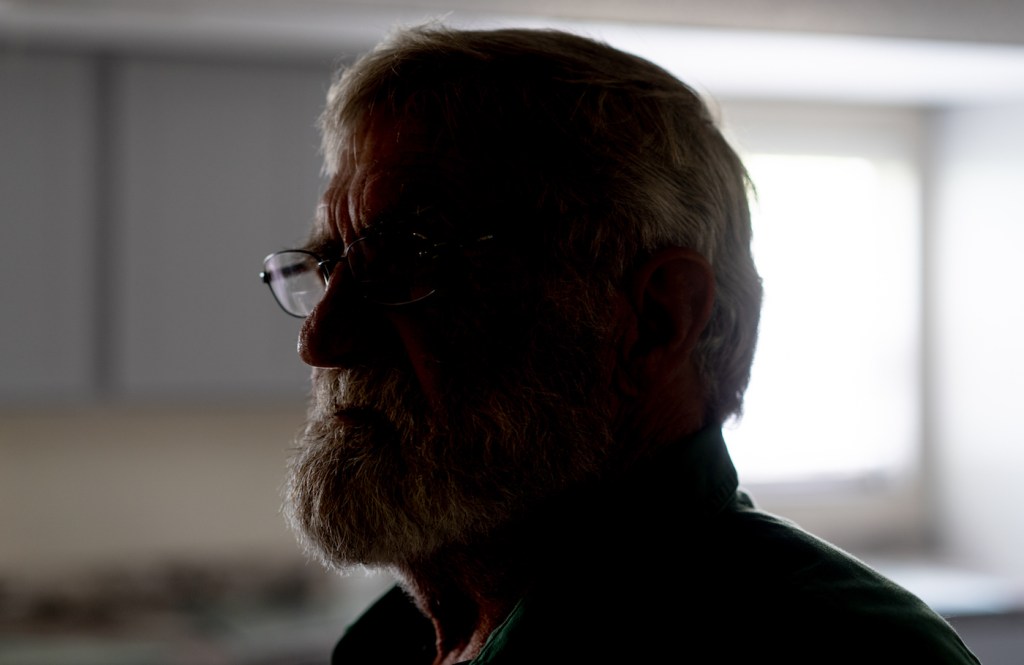
Don York is one of the property owners DNR missed.
He and his wife bought a house on six acres just south of the Litton site in 2006, intending to use it to run their construction business. The Yorks said they never would have bought the house had they known of contamination below the property.
A 2018 test of the well that supplied the Yorks with the water they drank, cooked with and bathed in contained more than 17 times the level of TCE that the U.S. Environmental Protection Agency considers safe.
“I feel like we’ve been deceived, we’ve been lied to,” York said.
“If we would have known, it might have helped understand the property. But not knowing, you don’t understand what you’re getting into…And now it’s junk.”
Northrop Grumman declined an interview for this story. Vic Beck, a Northrop Grumman spokesman, said in an email that for more than 30 years the company worked with the EPA and DNR to “investigate and remediate contamination at the former Litton site and surrounding areas” and is “committed to continuing these efforts to protect the local community.”
Beck’s statement bears similarities to one Northrop Grumman offered in response to a 2020 investigation by Newsday into the company’s TCE contamination in Bethpage, New York. The publication found that company officials knew for decades that it was contaminating groundwater with TCE but obscured that fact from the public.
Northrop Grumman is also implicated by the EPA as a responsible party for TCE contamination at several other locations around the country.
York is suing Northrop Grumman and others may join him.
Groundwater testing between 2018 and 2020 detected TCE at 87 properties within five miles of the former Litton site, with six registering amounts that exceed the EPA’s safety level multiple times.
Tom Aley, a hydrogeologist and founder of Ozark Underground Laboratory, said the presence of TCE, even below the EPA standard, carries risk.
“One sample is simply one sample,” Aley said. “And to have a number of detections of TCE, in this case that substantial number of wells, that is not a very safe groundwater supply for people to be using.”
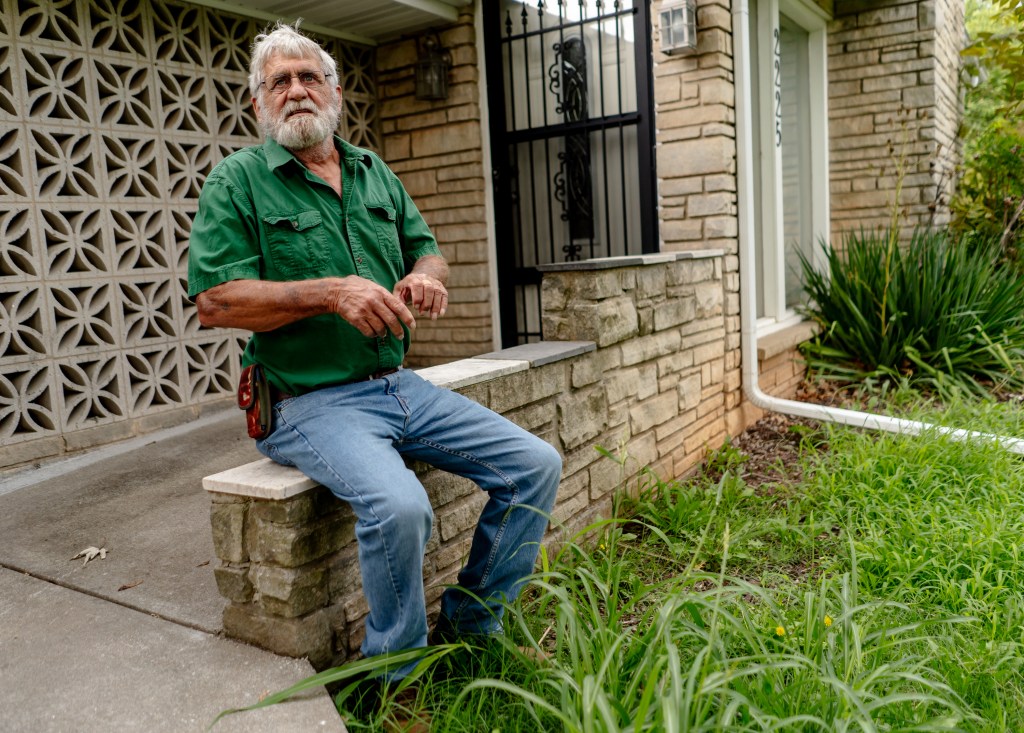
Hardly anything remains of Litton in Springfield — at least above ground. After Northrop Grumman closed the plant in 2007, nearly all its buildings met the wrecking ball. But the company’s legacy lives on in what’s left beneath the surface of the 70-acre site.
In its heyday, California-based Litton employed some 1,000 people in Springfield after it opened its manufacturing plant in 1963.
Litton’s Springfield operation primarily made printed electronic circuit boards for the Navy. One of the steps in the manufacturing process required employees to clean the circuit boards of grease and tape residue using TCE.
Before the EPA was established in 1970, Litton employees disposed of hazardous waste in ways that would be illegal today. John Brigance, who is retired and lives in Willard, Missouri, worked for Litton for 33 years. He said waste byproducts from circuit boards were often dumped into a pond on company property.
“They didn’t care what kind of chemical it was,” he said. “They all went in.”
Pat Brigance, John’s wife, worked for Litton from 1967 to 1975. “She recalled passing out from TCE fumes and feeling drunk when she regained consciousness.
“You don’t really know that it’s in the air,” she said. You just smell it and then it gets you high. It was very bad.”
Their accounts bear similarities to those of James Robinson, who worked for Litton in Springfield from 1967 until 2007. He testified in a 2017 lawsuit involving Northrop Grumman and several insurance companies that being around TCE also made him feel dizzy. Robinson said workers took barrels containing between 400 and 800 pounds of sludge out into outdoor pits and lagoons and simply dumped the contents.
“We had a tractor and a flatbed wagon, a flatbed trailer, and we set the 55-gallon drums on the trailer and haul it down to the field and turn them over, take the bones out of them, turn them over, and let them pour into whoever one they should be in,” Robinson testified, according to a transcript of the proceedings.
Robinson said he did not think dumping TCE into holes in the ground would contaminate groundwater.
“We had no idea of that,” Robinson testified. “I mean, I just always thought it evaporated.”
Robinson said he understood that the chemicals Litton disposed of in those pits were dangerously toxic.
Under questioning, Robinson described the lethality of the chemicals in Litton’s unlined pits.
Q: And in those holes…could you stand in those pits?
A: You could have, but I wouldn’t.
Q: Why wouldn’t you stand in those pits?
A: Acid and stuff in there.
Q: In fact, it was because it was full of highly toxic chemicals?
A: Yes.
Q: And if you stood in the pits, wouldn’t you expect to be dead?
A: Yes.
Making matters worse is the nature of the landscape in Springfield. Springfield has what’s known as karst topography, which means not far underneath the porous limestone ground throughout the region is a network of caves, sinkholes and waterways. And given that TCE is heavier than water, dumping the chemical in the ground means it can easily migrate downward into aquifers and water supplies.
Aley, the hydrogeologist, criticized the practice of dumping TCE in an outdoor lagoon.
“Well, when I first heard of the issue, I think it involved discharge of waste to a lagoon that was, which is basically a pond in which you put waste,” Aley said. “And putting … a lagoon in a sinkhole plain area is fundamentally — well, it’s a stupid move.”
Danny Eddington, also of Willard, worked at Litton at different times throughout his adult life. He said he witnessed the disposal of chemicals like TCE and sometimes did it himself.
“Well, nobody knew no better,” said Eddington, who was in hospice care during an interview for this story and died days later. “…We made a real mess out there.”

Litton’s hazardous waste disposal techniques got bad enough that the Missouri Attorney General sued the company in 1980. The lawsuit accused Litton of contaminating water supplies and sought an order to require the company to either seal its lagoon or quit using it.
“We believe the discharges are contaminating the underground water system in the area,” Missouri Attorney General John Ashcroft said in 1980.
Environmental testing the following year supported Ashcroft’s belief. A test of the water in Litton’s lagoon showed concentrations of volatile organic compounds, of which TCE is one, that far exceeded public health standards. High levels of TCE were found at nearby springs and the Little Sac River that year, too.
Among its responses to the contamination, Litton installed two monitoring wells to occasionally test groundwater for contaminants. But DNR records showed that one of those wells was destroyed and the other one dried up.
An April 1, 1982 story in the Springfield Leader & Press reported that residents who lived near Litton complained about the smell coming from the lagoon. It quoted one woman who said she thought the company would protect her safety.
“I feel a large corporation like that would take precautions to ensure our safety,” the woman told the newspaper. “Anyway, they’re creating jobs and in these times of high unemployment that’s important.”
In 1982, Litton eventually agreed to pay $50,000 in 1982 to settle claims by the state that the company violated hazardous waste laws, without admitting liability. And for a while, stories about Litton died down.
Litton wanted to sell its property in Springfield in 1991. During due diligence ahead of the sale, shallow groundwater testing revealed “significant” levels of contamination in the groundwater. Significant in this case meant concentrations of TCE in the groundwater under Litton’s property that reached 130,000 parts per billion, or 26,000 times higher than the level that the EPA considers safe in drinking water.
If the reported contamination was a surprise for Litton officials, DNR by that time had at least an idea about problems it posed.
That’s because groundwater testing in 1988 showed levels of TCE that exceeded safety standards in a private well north of Litton, as well as at Ritter Spring, which is several miles east of the industrial site.
A DNR inspection report from Jan. 27, 1988 noted that drinking water for about 150 people living north of Litton in the area could be potentially contaminated by solvents migrating from the company’s property.
DNR wrote an assessment in 1989 that noted the TCE tests but repeated what Northrop Grumman would often say about the presence of the contaminant: It could not be definitively traced back to the company.
That’s despite estimates developed later on that Litton generated between 34,000 and 200,000 gallons a day of wastewater from manufacturing circuit boards.
But the DNR document added that fact “does not negate the potential for pollution by chemicals found at the Litton site.”
At least one DNR employee at the time connected the contamination to Litton. A 1989 site inspection said that TCE found in the private well and Ritter Spring the year before “suggest off-site migration of contaminants.”

DNR officials in 1991 concluded that contamination on Litton’s property was bad enough that it should end up on the Missouri Registry of Confirmed Abandoned or Uncontrolled Hazardous Waste Disposal Sites.
When Litton learned about DNR’s thinking during a meeting on July 11, 1991, company officials said they wanted to quickly move ahead with their own plan to clean up their property, with the state supervising the process.
“We told them we would not want to discourage a cleanup, but that they would proceed at their own risk,” wrote DNR environmental specialist Kevin Kelly in his notes recounting the meeting.
Not long after, Litton and DNR started negotiating a consent agreement, essentially a contract outlining how the company would clean up its contamination with agency oversight.
When told of these negotiations, the EPA explained to DNR it would not step in if the state was carrying out its own clean up plan.
The EPA had been investigating Litton and received a report in 1993 from an environmental consultant that concluded that more than 200 people used water from wells within four miles of Litton’s property.
Experts tell the Midwest Newsroom that from the standpoint of a company with a pollution problem, DNR’s involvement is often preferable to that of the EPA, which is backed by the federal government’s vast resources.
“The state agency has even less resources and sophistication than EPA does in addressing these types of issues,” said Bob Menees, a Missouri attorney in private practice who previously worked for the Missouri Attorney General’s environmental division. “So I mean, if you would like, let's call it a boxing match: Would you rather go up against Muhammad Ali? Or would you rather go up against a mid-level fighter? You know, who do you have a better chance of knocking out? Or pushing around the ring? I mean, that's just the dynamic there.”
In 1993, Litton got its mid-level fighter. Litton and DNR reached a consent agreement in July that year.
Searches of archives of Missouri newspapers, including the Springfield News-Leader, The Kansas City Star and the St. Louis Post-Dispatch turned up no coverage of the consent agreement.
The agreement said that Litton would work to clean up contamination, crucially, within the boundaries of its own property. The consent agreement said that if it turned out that contamination spread beyond Litton’s property boundary, the terms of the agreement could be revisited to make the company carry out a wider cleanup.
But no investigation happened to determine the extent of the contamination. And several years later when they looked, contamination was found.
Everett Kennell has lived at a house on seven acres in northwest Springfield for 38 years. His house is less than a mile away from Fantastic Caverns.
So Kennell, a former writer and editor for the Springfield News Leader, was surprised and alarmed to first learn that TCE had shown up at the tourist destination.
“And then of course, it became clear that if the cave is contaminated with it, then what about the area around the cave?” Kennell said.
Kennell has since had the water at his home tested. The results showed levels of TCE within the EPA’s safety standard for drinking water. Still, he’s concerned, given that he raised his now 41-year-old daughter at the house.
“Things like that make you wonder, what else are they hiding from us?” Kennell said.
As early as 1993, DNR told Litton that its contamination was spreading beyond its property.
In a Nov. 18, 1993 letter to Litton, a DNR official who had examined the company’s cleanup plan identified several problems. One was the fact that all the monitoring wells on Litton’s property, installed to check the groundwater, detected contamination, a finding that to DNR meant “off-site migration had undoubtedly occurred.”
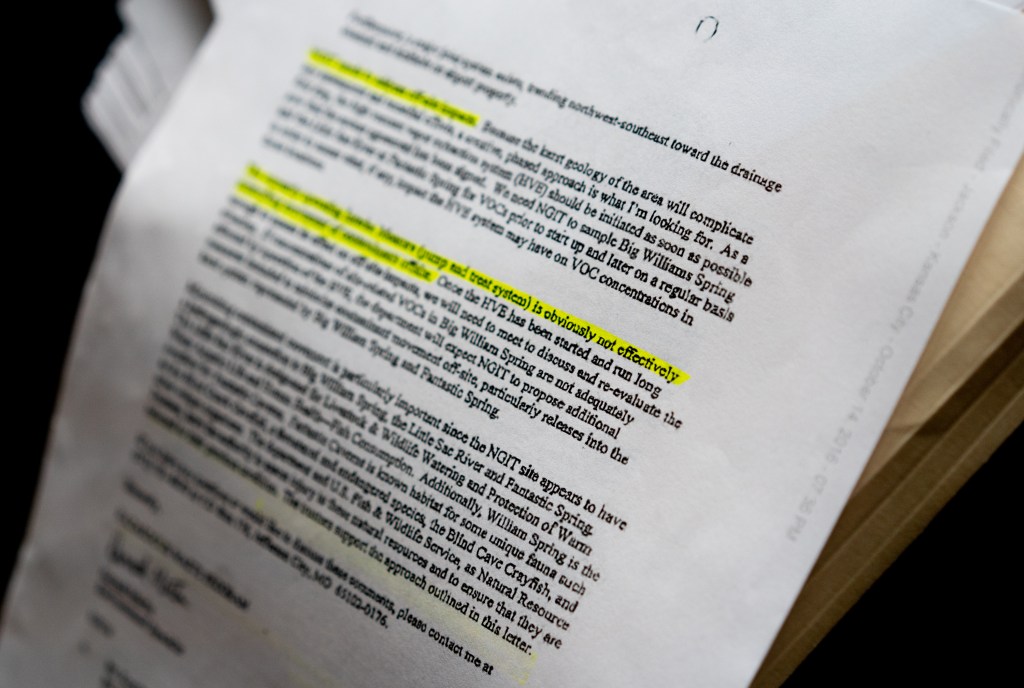
That letter later became a frequently-cited piece of evidence decades later during a 2017 trial stemming from a lawsuit when Northrop Grumman, which bought Litton in 2001, filed against several insurance companies in Jackson County. Northrop Grumman accused the insurers of refusing to cover the company’s environmental cleanup costs in Springfield.
The insurance companies argued that Northrop Grumman was responsible for Litton’s actions as a result of the buyout in 2001. They further argued that the company had known it had a contamination problem but didn’t file a claim until decades later. The insurers claimed that such a delay robbed them of an opportunity to investigate whether its policies covered the Springfield contamination.
“They (Litton) knew, the State told them, that off-site pollution had occurred,” jurors heard Ronald Puhala, an attorney representing one of Litton’s insurers, say at the 2017 trial, according to a transcript. ”Because the testing results of wells right along that airport property indicated that pollution was above limits and that pollution was moving right off into that airport property.”
More DNR employees became concerned about broader contamination.
In 1995, DNR environmental specialist Brian Allen pointed out in a memo that Litton’s cleanup plan lacked any investigation off-site where the pollution “obviously has gone.”
“When will they get around to extending the scope of their investigation off-site?” Allen wrote to another DNR employee.
That same year, Peter Price, the geologist who worked with DNR on contamination investigations, was dismayed to learn that wells on Litton’s property showed TCE at its highest concentrations coming from the Ozark aquifer deep beneath the ground.
“In short, this matter deserves some careful thought at this point. Do you recall if these sample results trigger some contingency plan?” Price wrote in a Nov. 16, 1995 email to a project manager.

The project manager disagreed with Price’s interpretation of the data.
“We can halt work on-site if you want us to,” Julie Warren wrote in response. “But I would prefer to get the IRM (interim remedial measure) up and running so we can at least control off-site migration in the Springfield Aquifer.”
It wasn’t just internal DNR employees alerting the agency about Litton’s pollution. In 1995, an engineering firm sent a report to DNR detailing the analysis of groundwater under the Springfield airport. The report said it found TCE in the groundwater and attributed it to the adjacent Litton site.
Price said companies often resisted off-site investigations unless they were forced to.
“There was certainly a feeling within our department that there was very likely… very likely, off-site contamination and investigation should be extended beyond the property boundaries of Litton’s property,” Price said in an interview. “They were reluctant to do that.”
That squared with Litton’s view of the situation: It didn’t investigate further because it didn’t have to.
During the 2017 trial between Northrop Grumman and its insurers, Northrop Grumman project manager Jeff Kuzemchak was quizzed by a lawyer about what Litton did to investigate contamination beyond its boundaries:
Q: So tell us, what sampling and analysis of groundwater off-site did Litton do in the early 1990s?
A: In the early 1990s, there was — there wasn’t any investigation conducted. There wasn’t any investigation required by this 1993 agreement. It wasn’t until the 2002 letter from MDNR.
Q: So — that’s exactly right. Nobody even — Litton didn’t even look beyond the property line to see if groundwater was impacted, did it?
A: No.
Q: And it wasn’t until 2002 that somebody came up with some evidence that there had been off-site contamination. Who came up with that evidence?
A: It was MDNR, based on sampling that was conducted by the airport, I believe.
On Sept. 21, 2001, a truck at the Springfield-Branson National Airport was traveling along a service road north of the main runway when it tipped over and spilled 1,600 gallons of jet fuel.
The airport called DNR and hired a consultant to investigate whether the spilled jet fuel posed an environmental threat.
Understanding that toxic chemicals could quickly seep into the groundwater, the consultant looked for signs of contamination in places where it might have spread — Ritter Springs, Big Williams Spring and Fantastic Caverns.
The investigation didn’t find signs of jet fuel in the groundwater. But it did find TCE at Big William Spring and other places. TCE wasn’t a chemical that the airport used, so the investigation concluded it came from somewhere else.

DNR concluded that somewhere else was the old Litton site.
DNR wrote to Northrop Grumman, which had bought Litton the year before, and explained the agency had “grave concerns” about the contamination that the airport’s investigation uncovered and laid blame at the company.
The letter was significant. It meant that DNR, after years of pushing Litton and Northrop Grumman to investigate whether they caused contamination in the wider area around their property, was finally ordering the company to do something about it. What’s more, DNR concluded that the company’s efforts up to that point to contain contamination to its property had failed.
“(Northrop Grumman) needs to address off-site impacts,” DNR’s letter said, adding later: “The current operating Interim Measure (pump and treat system) is obviously not effectively controlling movements of contaminants offsite.”
Northrop Grumman said it would deal with contamination tied to its facility, but maintained that other sources could put TCE in the groundwater.
In a letter response to DNR, the company said it believed other “potentially responsible parties” could have contributed to the pollution. The company did not suggest who those parties were.
As grave as DNR said its concerns were, they were apparently not serious enough to merit alerting the broader public. In response to questions for this story, DNR said its standard practice for similar sites, rather than issue a public statement, is instead to directly contact property owners, residents and workers in the area where an investigation is going on.
Steve Mahfood, who oversaw DNR from 1997 to 2005, said the Litton matter rarely became a matter for discussion at the top of the agency.
“A lot of times it takes somebody screaming about what’s going on and saying, ‘Hey, this is important to us,’” Mahfood said in an interview. “It enables people to shift priorities, reassess what they’re doing.”
DNR pointed to a 2010 public notice published in the Springfield News-Leader after the agency and Northrop Grumman reached a new cleanup agreement. The notice, which ran in small print on page 35 of the 40-page, Dec. 22, 2010, edition of the city’s daily newspaper, made no mention of off-site contamination.
Don York, whose well water had unsafe levels of TCE, said he paid close attention to the news, but the 2010 legal notice in the newspaper didn’t catch his eye.
“I used to read the newspaper a lot,” York said. “Now, I didn't go back into the one little corner of notices for the one notice they put out there. Why would I?”

The message the Yorks got from DNR in 2018 was urgent: There was TCE in their water.
“Don't drink the water. Don't brush your teeth with water. Don't take a shower in the water,” York recalled DNR telling him. “Don't get it on you.”
That was after years of using water from a well that ran deep under the house they bought in 2006 to run their construction business.
“We used the water to make coffee. We used the water to cook,” York said. “My wife and I oftentimes spent 16 to 18 hours there. We didn’t physically live there but it’s as close to living there as you could be.”
The Yorks learned of the threat to their house in 2018, just after Fantastic Caverns went public about the contamination of their property.
This was also just as the Yorks were completing a lease-purchase transaction with their daughter, Alisha York-Stradling and her husband, Jacob Stradling, who planned to use the property for the couple’s virtual reality video production business. The couple invested $125,000 into the property but have since moved their business out of the house and it sits largely unused.

York-Stradling viewed the public documents that formed the basis for this story.
“We're just so disappointed,” York-Stradling said. I don't know another word to use. Maybe mortified or outraged?” York-Stradling said. “But clearly, this is a known problem. And it's not just our family…but the whole area has been affected. So I'd say that's a failure on the part of everyone who had knowledge about this to do anything about it.”
It’s a point DNR doesn’t dispute.
“We apologize; we know we did not live up to our mission,” DNR’s Connie Patterson said in an email in response to questions for this story. “Going forward we are committed to doing better, investigating and not assuming, and prioritizing public outreach and communication.”
This story comes from the Midwest Newsroom, an investigative journalism collaboration including IPR, KCUR 89.3, Nebraska Public Media News, St. Louis Public Radio and NPR.
For more in-depth news from Iowa, Kansas, Missouri and Nebraska, we invite you to follow us on Twitter.
Invest in quality science journalism by making a donation to Science Friday.
Eric Schmid is the economic development reporter at St. Louis Public Radio in St. Louis, Missouri.
Steve Vockrodt is an investigative editor with the NPR Midwest Newsroom in Kansas City, Missouri.
IRA FLATOW: This is Science Friday. I’m Ira Flatow, and now, it’s time to check in on the state of science.
[AUDIO PLAYBACK]
– This is KER–
– –for WWNO.
– Saint Louis Public Radio.
– Iowa Public Radio News.
[PLAYBACK ENDS]
IRA FLATOW: Local science stories of national significance– in 2018, residents of Springfield, Missouri were shocked to learn that their groundwater contained elevated levels of TCE, trichloroethylene. This chemical was used for years at a local manufacturing plant and is thought to cause cancer, but a recent investigation has found that both the company and the Missouri Department of Natural Resources knew since the ’90s that contamination from the company’s property had seeped into the surrounding community.
Why was this kept secret for so long? Joining me now are my guests who unearthed this information, Eric Schmid, economic development reporter at Saint Louis Public Radio based in St. Louis, and Steve Vockrodt, investigative editor for the Midwest Newsroom based in Kansas City, Missouri. Welcome both of you to Science Friday.
ERIC SCHMID: Thank you so much for having us, Ira.
– Thanks for having us.
IRA FLATOW: Nice to have you. Eric, this story starts with the company Litton Systems. Tell us a little bit about Litton and what they made.
ERIC SCHMID: Sure. Litton Systems started operating in the Springfield area in the mid 1960s, and they were a defense contractor. And part of what they made there were these real big, thick, chunky circuit boards. And in the process of manufacturing these, it is dirty.
You have tape. You have grease. You have this residue. And so the company would use various chemicals, including trichloroethylene, to basically take away everything that they didn’t want on these boards after they were made. And it’s really good at getting this gunk away.
IRA FLATOW: Eric, when did concerns start to be raised about TCE in Springfield?
ERIC SCHMID: There are a couple of answers to that question. On the side of the government and regulators, it was in the 1980s and 1990s, but for regular everyday citizens who lived there, it wasn’t until around 2018.
IRA FLATOW: Were there signs among the workers that they feel ill? How did they know that there was something bad happening?
ERIC SCHMID: Yeah, so we did speak to a couple of different workers who described how, working with the chemical, they would feel dizzy after inhaling the vapors from it. Even one of them, she talked about how she passed out multiple times because she just didn’t know that it was in the air.
IRA FLATOW: Steve, let’s talk about the Fantastic Caverns, a tourist attraction where people can tour a cave under Springfield in a Jeep-drawn tram. What was discovered at Fantastic Caverns?
STEVE VOCKRODT: So Fantastic Caverns was an important inflection point in this whole saga because the presence of TCE in the community was not particularly well known until Fantastic Caverns started speaking up about it in 2018, saying, there is TCE at our location. We’re about five miles North of the Litton Systems site.
And they attributed the presence of TCE at Fantastic Caverns to Litton in their long-ago activities with manufacturing. The company has maintained that there could have been other sources in Springfield that contributed to the contamination in the groundwater. But Fantastic Caverns has said that TCE was found in areas that tourists didn’t visit, and they later drilled ventilation holes to let the vapors escape from the caves.
It was at that point that the Missouri Department of Natural Resources started to undertake a deeper investigation of where the contamination was in Springfield. And that’s when some people started to discover that their private wells, where they got their groundwater to drink, to bathe, to cook, had TCEs. In some cases, the levels of TCE were higher than what even the EPA considers safe. And so that was the first time in decades that people had gotten the idea that the groundwater was contaminated, that it had spread beyond this contractor’s site, and that people had been exposed to it.
IRA FLATOW: Yeah, yeah, and Eric, what do we know about the health effects of TCE?
ERIC SCHMID: We know that breathing in TCE can cause some types of cancer, and we spoke with Litton workers, who they attribute working with the chemical and breathing it in with the deaths of many people in their community. One of the people who we spoke with was Pat [? Brigance. ?] She says that her friends, her sister, her brother-in-law, who we also interviewed for this story and, in fact, died a few days after we spoke with him– she says that that was the result of working with those chemicals.
[? PAT BRIGANCE: ?] I’d hate to say how many people that they died with cancer and that everybody that we get together with talks about it because there’s so many of them.
ERIC SCHMID: It’s really important for us to say, as reporters, we can’t say whether or not TCE causes cancer. There haven’t been enough epidemiological studies or real scientifically founded investigations to say that TCE causes cancer. And even some of the lawyers that we spoke to during the reporting of this story were cautioning us about whether or not we can make those claims.
IRA FLATOW: If the Missouri Department of Natural Resources knew since the ’90s that there was this contamination, why was it held secret, and how are they dealing with exposing that knowledge?
STEVE VOCKRODT: We found documents in our reporting that showed that as early as 1993 and continuing for years afterwards, there were employees at the Department of Natural Resources in Missouri who were saying, look, based on this data that we have, the groundwater contamination in the contamination from Litton Systems has to be spreading further. When are they going to investigate further?
But in 1983, the company in the state reached this agreement that said we will clean up the contamination on our site. The agreement didn’t say that they would investigate beyond their site, and so that’s what they stuck with until that jet fuel spill I was talking about in 2002, which kind of forced everybody’s hand because the realization was from a third party now that contamination had been spreading from this site.
The Department of Natural Resources has publicly apologized. They apologized again to us in a statement when we were doing this reporting, saying that they didn’t live up to their mission and that, in future cases like this, they’re not going to rely on assumptions. They’re going to do more investigation. And so they have acknowledged that they didn’t quite do the job that they needed to do.
IRA FLATOW: Well, I want to thank you both for taking time to be with us today and telling us what you know. Thank you for joining us.
ERIC SCHMID: Yes, thanks for having us. It was a blast.
STEVE VOCKRODT: It was a pleasure. Thanks for having us.
IRA FLATOW: Eric Schmid, economic development reporter for Saint Louis Public Radio in Saint Louis, Missouri, and Steve Vockrodt, investigative editor for the Midwest Newsroom based in Kansas City, Missouri. And if you want to read Eric and Steve’s full investigation, you can do so on sciencefriday.com/stateofscience.
Copyright © 2022 Science Friday Initiative. All rights reserved. Science Friday transcripts are produced on a tight deadline by 3Play Media. Fidelity to the original aired/published audio or video file might vary, and text might be updated or amended in the future. For the authoritative record of Science Friday’s programming, please visit the original aired/published recording. For terms of use and more information, visit our policies pages at http://www.sciencefriday.com/about/policies/.
Kathleen Davis is a producer and fill-in host at Science Friday, which means she spends her weeks researching, writing, editing, and sometimes talking into a microphone. She’s always eager to talk about freshwater lakes and Coney Island diners.
Ira Flatow is the founder and host of Science Friday. His green thumb has revived many an office plant at death’s door.